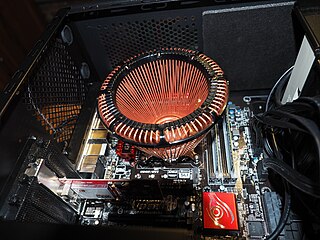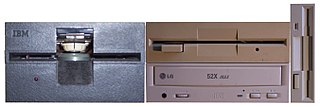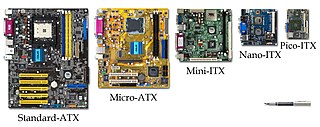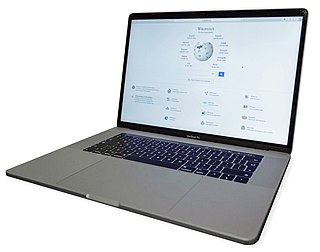
Computer data storage is a technology consisting of computer components and recording media that are used to retain digital data. It is a core function and fundamental component of computers.

A laptop, laptop computer, or notebook computer is a small, portable personal computer (PC) with a screen and alphanumeric keyboard. Laptops typically have a clam shell form factor with the screen mounted on the inside of the upper lid and the keyboard on the inside of the lower lid, although 2-in-1 PCs with a detachable keyboard are often marketed as laptops or as having a "laptop mode". Laptops are folded shut for transportation, and thus are suitable for mobile use. They are so named because they can be practically placed on a person's lap when being used. Today, laptops are used in a variety of settings, such as at work, in education, for playing games, web browsing, for personal multimedia, and for general home computer use.

A quiet, silent or fanless PC is a personal computer that makes very little or no noise. Common uses for quiet PCs include video editing, sound mixing and home theater PCs, but noise reduction techniques can also be used to greatly reduce the noise from servers. There is currently no standard definition for a "quiet PC", and the term is generally not used in a business context, but by individuals and the businesses catering to them.

A disk enclosure is a specialized casing designed to hold and power disk drives while providing a mechanism to allow them to communicate to one or more separate computers.

A drive bay is a standard-sized area for adding hardware to a computer. Most drive bays are fixed to the inside of a case, but some can be removed.

Small form factor is a term used for desktop computers, and their enclosures and motherboards, to indicate that they are designed in accordance with one of several standardized computer form factors intended to minimize the volume and footprint of a desktop computer compared to the standard ATX form factor.

The MacBook Pro is a line of Macintosh notebook computers by Apple Inc. Introduced in January 2006, it is the higher-end model of the MacBook family, sitting above the consumer-focused MacBook Air. It is currently sold with 13-inch, 14-inch, and 16-inch screens, all using variants of the Apple-designed M1 and M2 system on a chip.

The Tecra is a series of business laptops currently manufactured by Dynabook Inc., a subsidiary of Sharp Corporation formerly owned by Toshiba. The number of Tecra notebook models available for sale is strictly dependent on the location: North and South America, Europe, Africa and South Africa, the Middle East or the South Pacific region.

The history of laptops describes the efforts, begun in the 1970s, to build small, portable personal computers that combine the components, inputs, outputs and capabilities of a desktop computer in a small chassis.

HP Mini is a former line of small computers categorized as netbooks manufactured by Hewlett-Packard. They either contained a custom version of Ubuntu Linux, Microsoft Windows XP Home Edition or Windows 7 Starter operating system. Like most netbooks, they were not built with CD/DVD drives. However, HP did sell portable DVD-ROMs with HP's LightScribe disc imaging software. These netbooks are best used for written documents, small programs and web browsing. They can run standard software, but given their low price, they tend to have low end specifications, causing poor performance. They were announced from mid-2007, and marketed from 2008 through 2012.
Sony VAIO AR series was a range of high-end multimedia notebook computers from Sony introduced in June 2006 as the first laptop with integrated Blu-ray drive. It replaced the AX Series. It featured a 17" 16:10 widescreen LCD screen, with choice of 1440x900 or 1920x1200 resolutions. It was replaced by the AW series.
This glossary of computer hardware terms is a list of definitions of terms and concepts related to computer hardware, i.e. the physical and structural components of computers, architectural issues, and peripheral devices.

Aspire Timeline is a series of notebook computers manufactured by Acer Inc. designed to achieve battery life in excess of eight hours with ultrathin designs. The first generation Acer Timeline models use Intel's ultra low voltage (ULV) processors and Intel's Laminar Wall Jet technology.

The ThinkPad T series is a line of laptop computers. Originally developed by IBM, and introduced in 2000, the brand was sold along with the rest of IBM's consumer computer division to Chinese technology company Lenovo in 2005, who have continued to produce and market succeeding models.

The ThinkPad X series is a line of laptop computers and convertible tablets produced by Lenovo with less power than its other counterparts. It was initially produced by IBM until 2005.

The IdeaPad Y series was a consumer range of laptops produced by Lenovo, first announced in 2008. They are marketed as premium high performance laptops for multimedia and gaming, as part of the IdeaPad line. The most significant differences from Lenovo's traditional ThinkPad business laptops were a more consumer-oriented appearance and performance-oriented components. IdeaPads feature a chiclet keyboard with rounded keys, similar to the latest ThinkPads. The first of the Y series were the IdeaPad Y710 and the IdeaPad Y510 notebooks, with screen sizes of 17 inches and 15 inches respectively. Not all features were entirely new, however. Notebook Review reported that the Y710 and Y510 notebooks had a keyboard that felt similar to the ThinkPad when used, despite the absence of the TrackPoint. The Y50 and Y40, released in 2014, featured a gaming-oriented design shift and slimming down. The latest release was the Y700 in late 2015.
Lenovo’s IdeaCentre A Series is a line of all-in-one desktops designed primarily for home use and the consumer PC segment. The sections below describe the IdeaCentre A Series desktops, categorized by their year of release.
In addition to the ThinkPad and IdeaPad laptops, Lenovo also offers a value-priced series of laptops. Called ‘Essential’ on the Lenovo web site, the products available in this line include the G Series, B Series, and V Series. Launched in 2009, the first laptop in the Essential range was the G530.
Lenovo’s line of Essential desktops is a collection of budget-conscious machines designed for consumers, and advertised as being "affordable, space saving, and energy efficient". The Essential desktop line is different from both Lenovo’s ThinkCentre line and Lenovo’s IdeaCentre line. Lenovo defines its ThinkCentre desktops as business-oriented computers, while the IdeaCentre desktops are meant primarily for entertainment. The Essential range of desktops can be categorized as being between the two – meant more for ordinary everyday use.

The Intel-based MacBook Pro is a discontinued line of Macintosh notebook computers sold by Apple Inc. from 2006 to 2021. It was the higher-end model of the MacBook family, sitting above the consumer-focused MacBook Air, and was sold with 13-inch to 17-inch screens.














